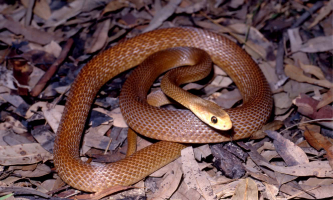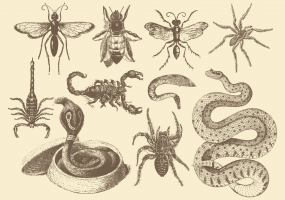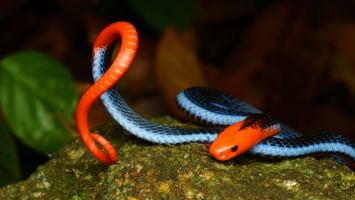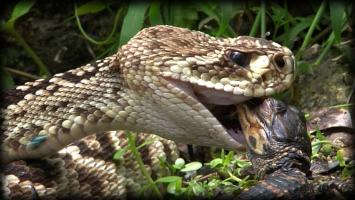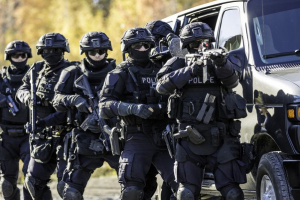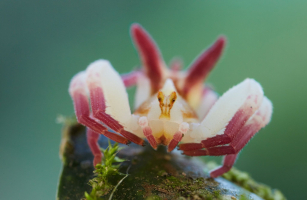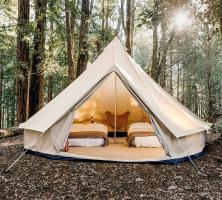Top 10 Most Venomous Snakes
Venomous snake bites are one of the leading causes of human death. The risk of death is very high and develops very quickly if the victim does not have timely ... read more...treatment. According to WHO statistics in 2019, every year, 80,000 - 140,000 people around the world die from venomous snake bites, this number is higher than the number of deaths from infectious diseases such as dengue fever or rabies. That shows, venomous snakes are a dangerous animal that humans need to pay attention to. In this article, Toplist will explore with you "Top 10 most venomous snakes".
-
Belcher's Sea Snake (scientific name is Hydrophis Belcheri) is a venomous snake that lives in the sea. They usually feed at night and are very gentle, Belcher's Sea Snake only attacks people when accidentally caught by fishermen and a quarter of the cases are bitten but not poisoned because they do not inject venom into the victim's body. However, their gentle nature does not mean they are not dangerous, Belcher's Sea Snake is researched as the most powerful venomous snake in the world, 100 times stronger than the Inland Taipan.
They have an average size of 0.5 - 1m and are chromium yellow with dark green cavities. Belcher's Sea Snake usually eats small floating creatures that live in the water. When in the water, they use their tails to swim and move forward, so they move quite quickly. Belcher's Sea Snake can hold its breath for up to 8 hours underwater to feed and occasionally come to the surface to breathe.
When bitten by this snake and injected with venom, there is no way to cure it, the victim will die within a few minutes. A few mg of Belcher's Sea Snake's venom is enough to kill 1,000 people. Therefore, they are considered one of the most venomous snakes in the world.
Country: Southeast Asia and Northern Australia.
Habitat: Sea.
Length: Average 0.5m - 1m.
Lethal time: Few minutes.
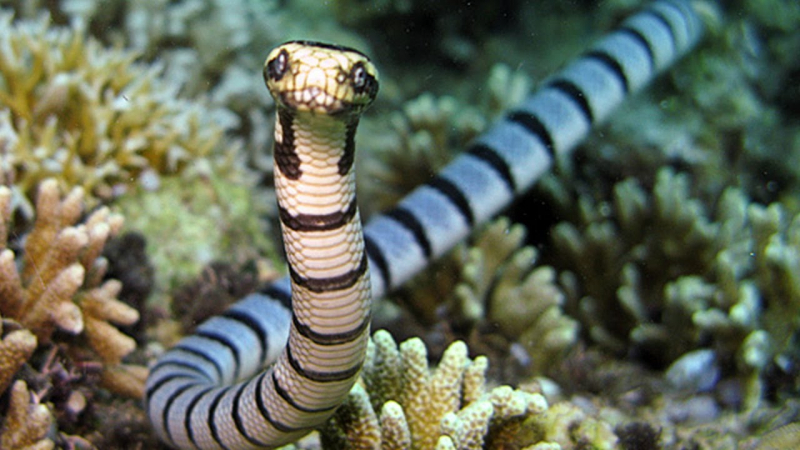
Source: critter.science 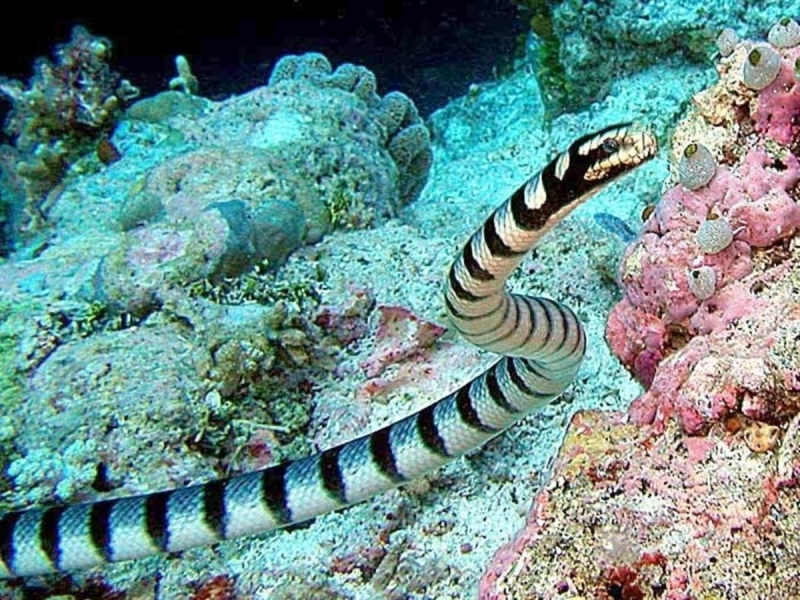
Source: owlcation.com -
The Eastern Brown Snake (scientific name is Pseudonaja Textilis) is one of the most venomous snakes in the world. This snake is present everywhere in Australia but is concentrated mainly in the central region. The Eastern Brown Snake is one of the leading causes of snakebite deaths in Australia. Usually, they are glossy brown, may also have spots and stripes, have different color patches,... The juveniles have a grayish-black horizontal stripe and many red spots on the abdomen.
Due to its rather aggressive nature, the Eastern Brown Snake is very dangerous to humans. They will be ready to attack when necessary. This snake is mainly active during the day. When excited, they stretch their necks into an S shape and prepare to attack their prey. They have diverse habitats, from wet places to dry places. However, they do not live in very arid places such as tropical forests or places with high humidity.
Eastern Brown Snake's food is usually vertebrates such as lizards, birds, frogs, snakes, and rodents. They capture their prey and destroy it by delivering venom and squeezing the prey. The Eastern Brown Snake has more or less venom depending on its size. On average, one time of venom collection in the laboratory yielded 4.7mg of venom.
Country: Australia.
Habitat: All environments except jungle.
Length: Average 1.5m - 1.8m.
Lethal time: About 15 minutes.
Venom/bite: 40-70mg.
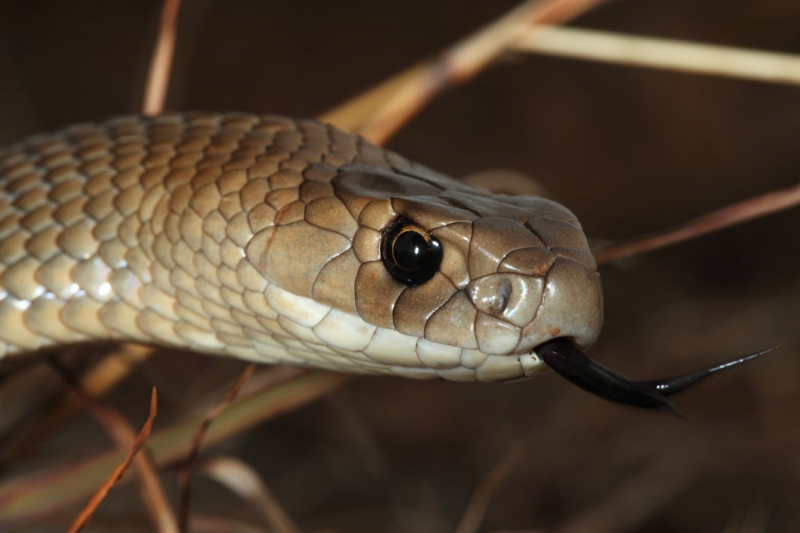
Source: australian.museum 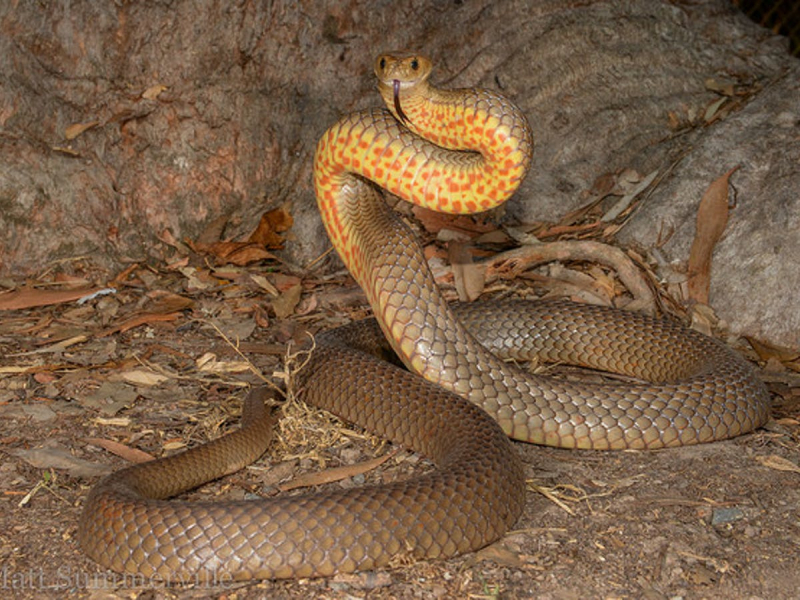
Source: theconversation.com -
The Mainland Tigersnake is another very dangerous venomous snake that is "homed" in Australia. Their venom has evolved almost completely 10 million years ago and is considered a challenger in the evolutionary race of venom. The venom of this snake makes the human body unable to clot, which is life-threatening. They appear along the southwest and southeast coasts of Australia, often living in areas close to homes, so they bring an incalculable danger to humans.
Mainland Tigersnake has a very aggressive and excitable nature, so it will be very dangerous and risky when faced with them. The venom of this snake is 50 times stronger than the venom of a common cobra. About 17% of all snakebites in Australia are attributed to the Mainland Tigersnake, with 4 deaths out of 119 bites.
The length of the Mainland Tigersnake ranges from 1 - 1.8m. Their venom has a great effect on the human nervous system. It attacks the central nervous system directly, causing muscle damage and blood clotting protein disorders. This venom helps Mainland Tigersnake kill prey such as amphibians, birds, mammals, and reptiles.
Country: Australia.
Habitat: Wet areas close to houses.
Length: Average 1m - 1.8m.
Lethal time: About 30 minutes.
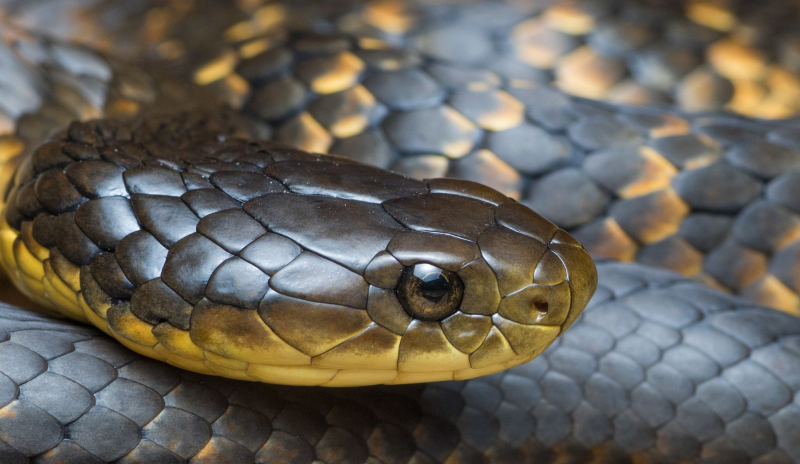
Source: australiangeographic.com.au 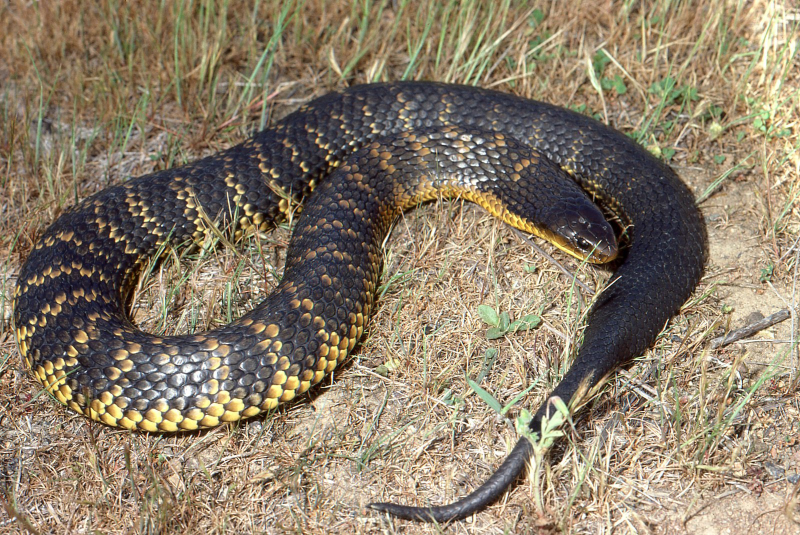
Source: australian.museum -
King Cobra (scientific name is Ophiophagus Hannah) is the most intelligent cobra and has a talent for building nests that other cobras do not have. They can communicate with other snakes. In addition, they are highly territorial, especially male. They hate other males entering their territory, so there are often heated fights between two male King Cobras. King Cobra is also the longest venomous snake with a recorded length of up to 7m.
King Cobra normally has a length of 3.6 - 4.2m. They appear to be a "king", when in danger, they raise 1/3 of their body, staring at the enemy to prepare a posture ready to attack. With their poison resistance, they love to eat other venomous snakes such as Rattlesnakes, Black Mamba snakes, ... and even their kind. Some King Cobras have very strict diets where they eat only one species of snake.
King Cobra's venom has a very terrible effect, although not the most deadly, it can kill an adult elephant. Due to their large and strong bodies, they can inject large amounts of venom into their prey and cause them to die.
Country: Stretching from India to Southeast Asia.
Habitat: Lake or stream, forest.
Length: Average 3.6m - 4.2m.
Lethal time: About 30 minutes.
Venom/bite: 400-500mg.
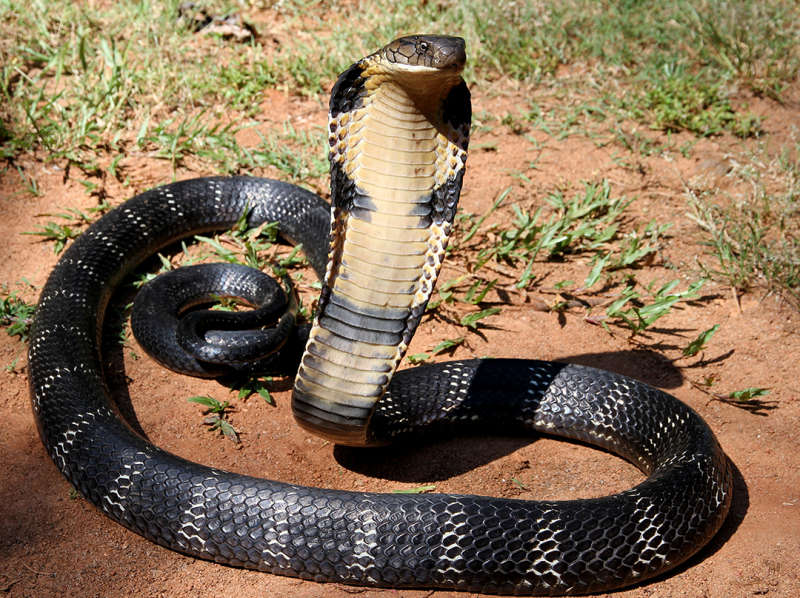
Source: vi.wikipedia.org 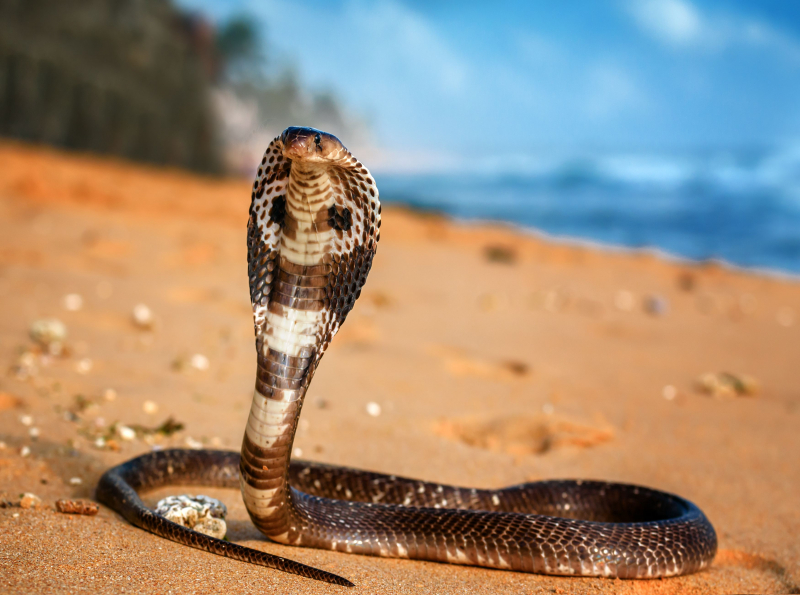
Source: thoughtco.com -
The Inland Taipan (Oxyuranus Microlepidotus) is an extremely venomous Australian snake that is one of the most venomous of all terrestrial snakes and is considered the most terrible "nightmare" in Australia. However, the nature of this snake is quite shy, they often run away when incidents occur. Therefore, snakebites and deaths from snakebites are often recorded with little occurrence of this snake.
In addition to the ability to kill prey with venom, they also have for themselves another "specialty" that helps them in hunting, which is the ability to change color from dark brown to dark green or dark olive green. Their skin color changes differently depending on the season.
Inland Taipan has a length of about 1.8 - 2.5m. Their food is usually rodents or birds and they often live in dry environments, where there is much prey such as rat dens. The venom of the Inland Taipan is very strong, 10 times stronger than the Mojave rattlesnake and 50 times stronger than the venom of a common cobra. They can cause 100 people to die after 45 minutes without timely medical intervention with only 110 mg of venom.
Country: Australia.
Habitat: Dry plains, in the dens of native rat species.
Length: Average 1.8m - 2.5m.
Lethal time: About 45 minutes.
Venom/bite: < 100mg.
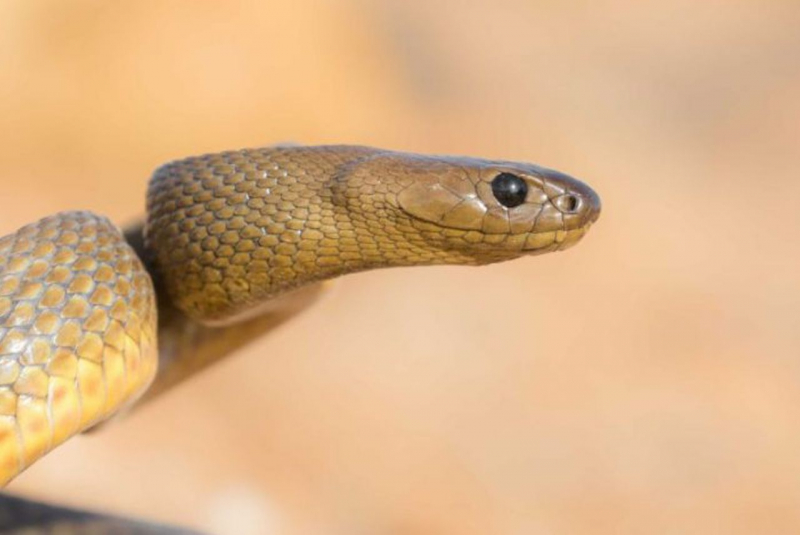
Source: doisongphapluat.com 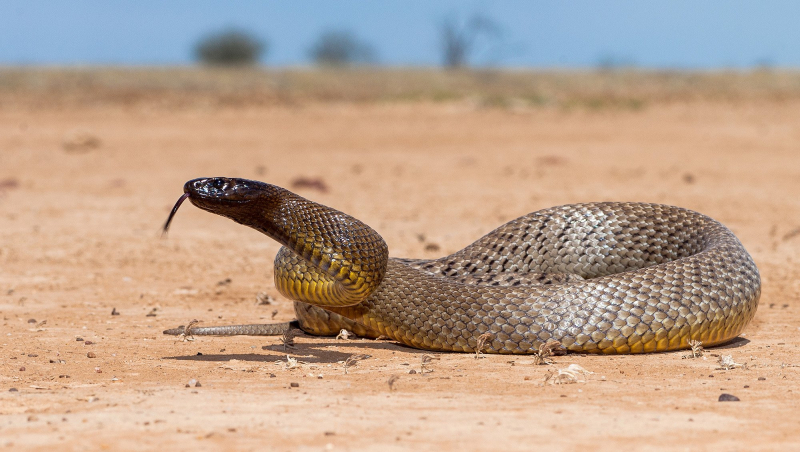
Source: australiangeographic.com.au -
The Black Mamba (Dendroaspis Polylepis) is a venomous snake of the cobra family found in the low Sahara. They are given the name "Black Mamba" not because of the color of their skin but because the inside of their mouth is black, the scales of the Black Mamba's body are smoky gray. In folklore, people also nickname this snake-like "African Black Death", "black coffin killer", "speed king", ... to refer to their danger.
Black Mamba usually live underground, they rarely climb trees. This snake is also very afraid of people, but they will become aggressive when someone tries to invade their territory. The Black Mamba is the second-longest snake in the world (after the King Cobra) and the longest in Africa. They run very fast, some Africans recount times being chased by Black Mamba at high speed, or there are cases of consecutive bites that lead to death.
Black Mamba's venom is very strong and can kill a rat within 4.5 minutes. When people are bitten, the symptoms affecting the nervous system include headache, metallic taste in the mouth,... If not treated in time, it can cause paralysis of the nervous system, abnormally fast heart rate and lead to death due to respiratory failure, heart failure.
Country: Sub-Saharan Africa.
Habitat: Dry grasslands, open forests, rocky slopes, dense forests.
Length: Average 2m - 3m.
Lethal time: About 45 minutes.
Venom/bite: 100–120 mg.
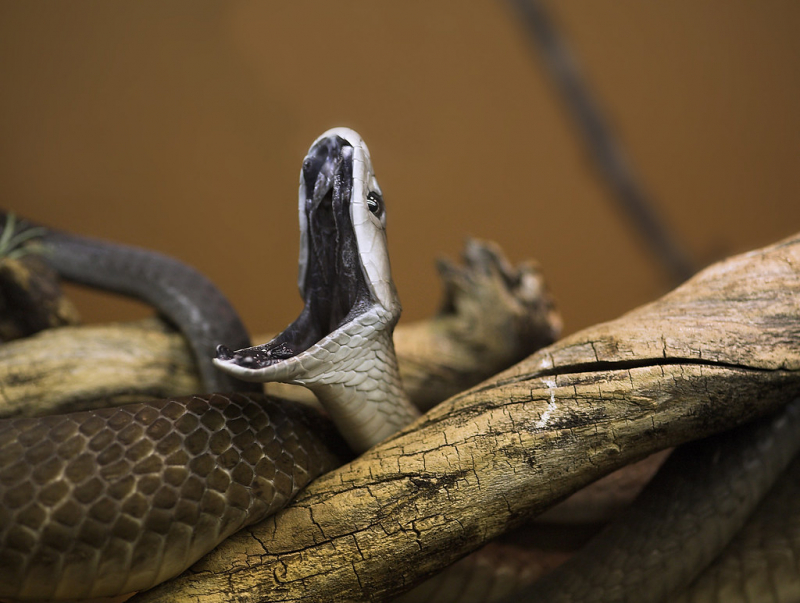
Source: flickr.com 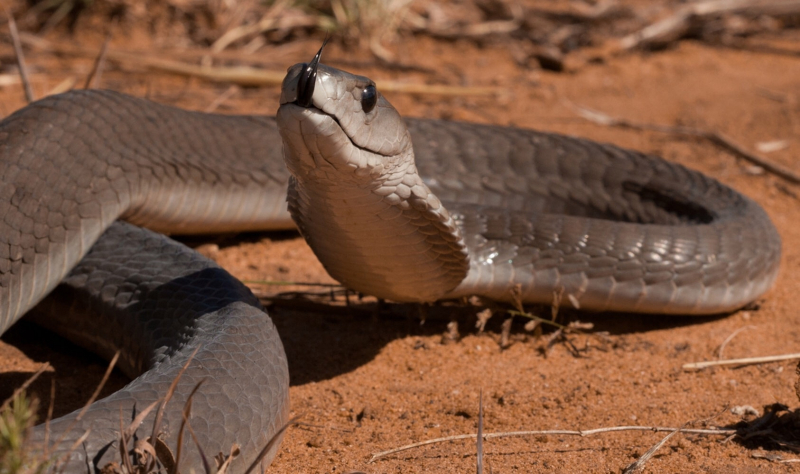
Source: quora.com -
Common Death Adder is a venomous snake species that occurs quite commonly in the Sydney bush region of Australia, in addition, they are also distributed in New Guinea. Like its name - "Common Death Adder" - the venom of this snake is very dangerous and highly lethal to humans. Although they are less than 1m long, they are a formidable opponent of other creatures and humans.
Common Death Adder is a master of "disguise". Most snakes will hide when they see a threat, but the Common Death Adder is different, they often "disguise" hiding in the bushes, waiting for prey to pass by and launch a surprise attack. That's why many people are bitten by them but unable to keep up. When hunting, they use their tails as bait. The prey will be attracted and it will attack in a flash, killing the prey instantly.
Common Death Adder's teeth are very long, leaving a very deep wound when bitten. They possess highly toxic venom and affect the nervous system, causing the victim to gradually lose the ability to feel. After that, the victim will be paralyzed, lose consciousness and die if not treated promptly. Common Death Adder becomes even more dangerous to humans when they live near people and pets. Therefore, it is necessary to be very careful with this snake.
Country: Australia and New Guinea.
Habitat: Forest, grassland.
Length: Average 0.7m - 1m.
Lethal time: About 6 hours.
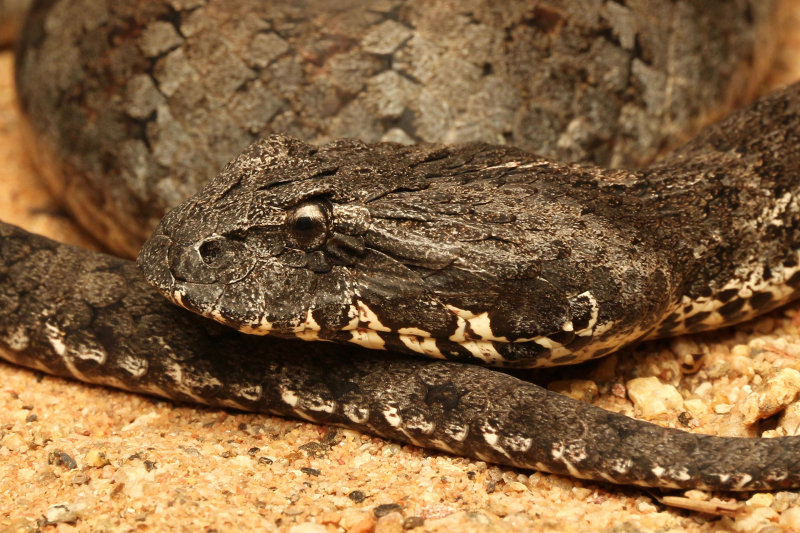
Source: southeastsnakecatcher.com.au 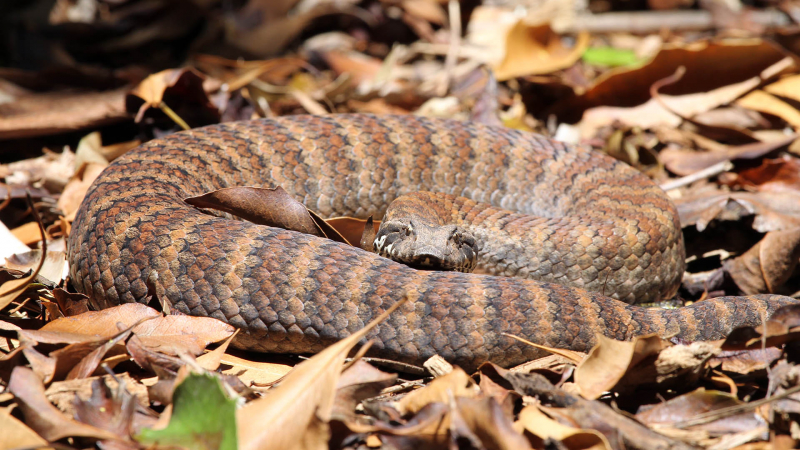
Source: perthzoo.wa.gov.au -
Blue Krait (scientific name is Bungarus Candidus) is a venomous snake species most commonly found in Indonesia and Southeast Asian countries. Blue Krait belongs to the family of cobras, with the distinguishing feature of smooth scaly skin, alternating colors between white and black, or yellow and black. Their venom ranks as one of the most powerful of all snakes. However, their nature preferred to hide rather than attack.
The usual length of this snake is about 1 - 1.5m, but there are also larger sizes with 2 - 2.5m long. They usually feed at night, that's why they are usually very gentle during the day but become aggressive at night. Their prey is other snakes, sometimes they eat their kind. Blue Krait does not hunt for prey, but often lies and waits for prey to pass and "make moves", they often crawl under the light of the fire and swim very well.
Blue Krait's venom is completely neurotoxic, without protein poison. This poison is 16 times stronger than the venom of a common cobra. When bitten, the victim does not die immediately but will die after 6-12 hours. Usually, the deaths are due to painless and swollen wounds that many people are subjective and don't even know they have been bitten by a snake.
Country: Southeast Asia, Indonesia.
Habitat: Earthy mountains, open forests, grasslands, streams, upland fields.
Length: Average 1m - 2.25m.
Lethal time: 6 - 12 hours.
Venom/bite: 4.6-18.4mg.
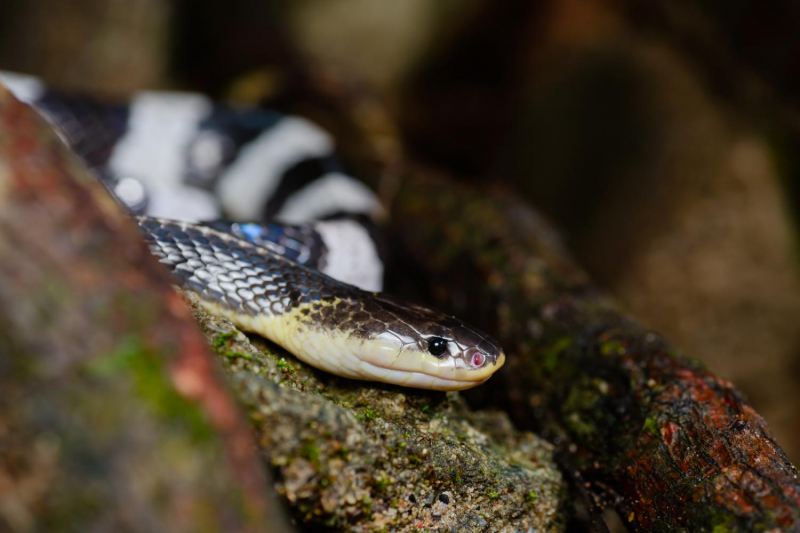
Source: thainationalparks.com 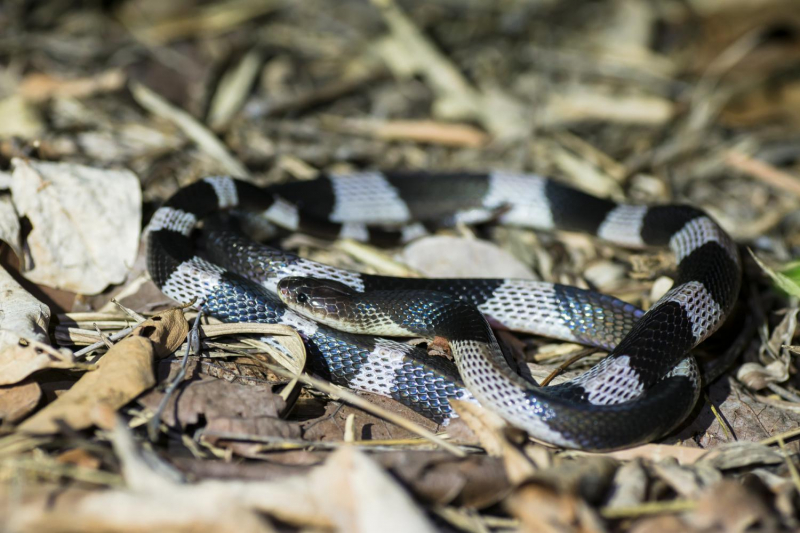
Source: thainationalparks.com -
Boomslang is the most venomous snake in the Colubrid family with an average length of about 1 - 1.6m, some even have a length of 1.83m. They have very good eyesight on par with a normal human. Males are usually bright green, with a greenish-black head, and females may be brown. Boomslang's main food is small amphibians such as toads and lizards. In addition, they sometimes "change their taste" to certain small mammals, bird eggs, and birds by devouring.
Boomslang can kill people and there have been several deaths due to Boomslang before. However, due to their body structure with fangs growing in the back, it is more difficult for them to inject venom into the victim's body than other snakes. As a result, deaths from this snake were few and even in the past, it was thought to be harmless.
Boomslang only bites when they feel threatened such as by accidental touch. Their venom not only causes symptoms such as nausea, headaches, drowsiness, anxiety, but also blood clotting disorders. More terrifying is that when bitten, the victim will have brain and muscle hemorrhage, blood will flow out all the openings on the body such as nose, ears, teeth, eyes, and even the smallest wounds. Blood can also follow urine, feces, saliva, ... and so on, the victim will lose blood and die.
Country: Africa.
Habitat: Forest, on the tree.
Length: Average 1m - 1.6m.
Lethal time: About 1 day.
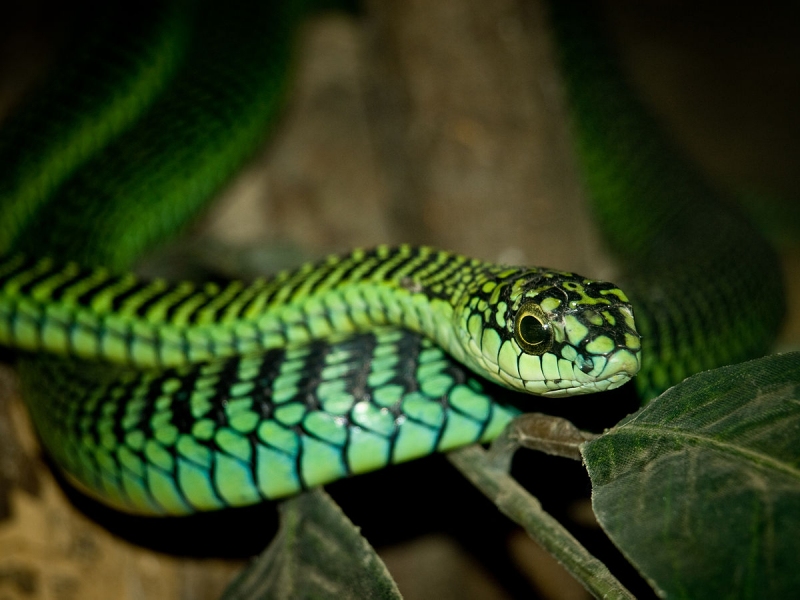
Source: en.wikipedia.org 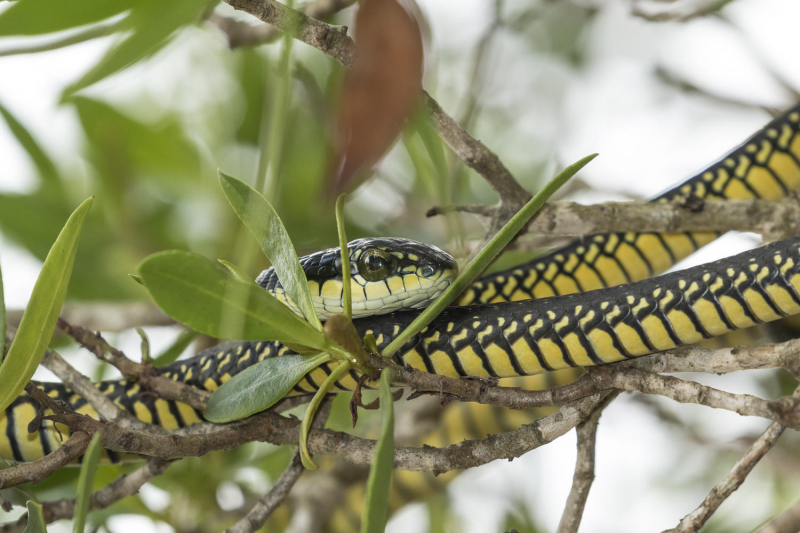
Source: inaturalist.org -
The Mojave Rattlesnake (Crotalus Scutellatus) is the most venomous snake species in the United States, occurring in the deserts of central Mexico and the southwestern United States. The distinguishing feature of their presence is the tail emitting a sound like a bell. This snake has an average length of less than 1m, the longest is only 1.37m. Mojave Rattlesnake usually lives in deserts and low mountain slopes, or places with sparse vegetation, grasslands, etc.
The Mojave Rattlesnake typically feeds on some mammals, amphibians, reptiles, birds, lizards, and small rodents. They are usually brown and light green depending on their surroundings, but the Mojave Rattlesnake is sometimes seen as green in some areas. This snake is highly self-defensive when threatened, like most snakes.
Their venom effects vary depending on the different species, but most of their venom is very toxic. Their venom paralyzes the prey's nerves and causes the heart to stop beating within minutes. To humans, Mojave Rattlesnake's venom is rarely fatal, but it has serious consequences. Their venom penetrates the body causing blood clotting disorders, destroying tissue causing necrosis. Bites that are not treated in time can lead to death.
Country: Southwestern United States and central Mexico.
Habitat: Desert or mountainside. delta, open and dry living environment.
Length: Average 1m.
Lethal time: It is rarely fatal but has serious consequences.
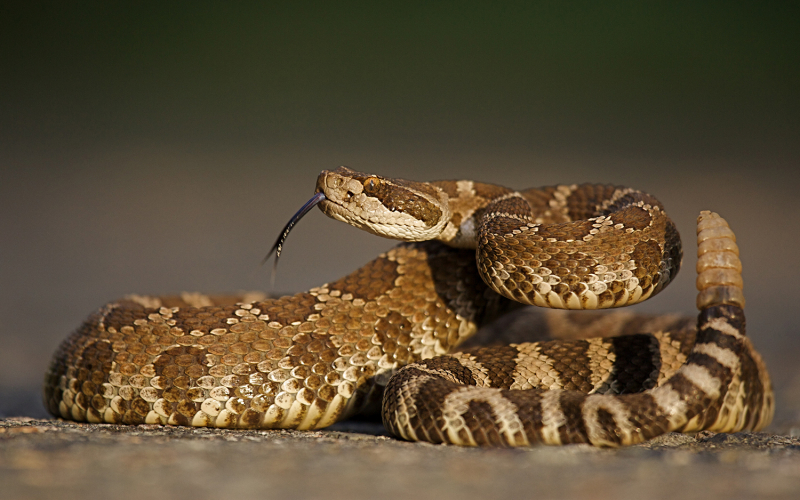
Source: livescience.com 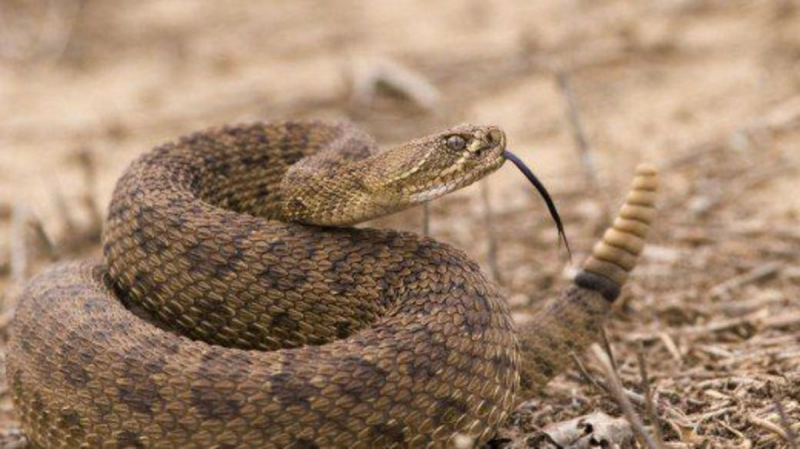
Source: owlcation.com












